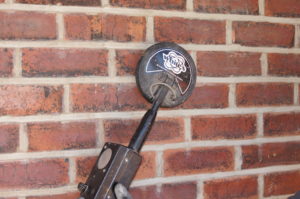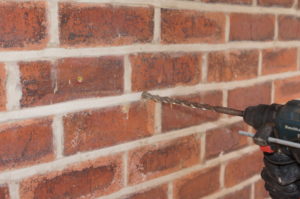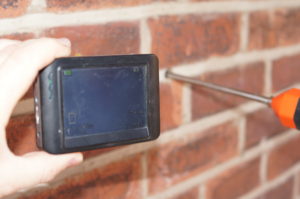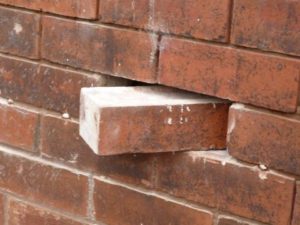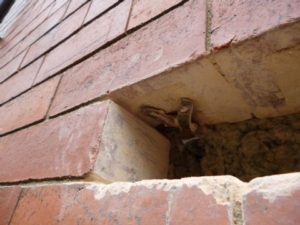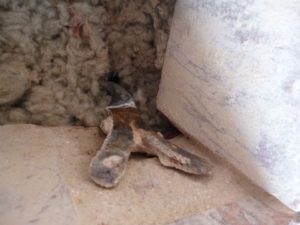We are Experts in Cavity Wall Tie inspection, installation, replacement & treatments covering Leeds, Harrogate, Wakefield & all surrounding areas!
What are Cavity Wall Ties?
The purpose of a cavity wall tie is to link the inner and outer leaf of a cavity wall together, giving stability to the wall. Without them, the relatively thin inner and outer walls will prove too weak to support loads and resist lateral forces with stability being worse the higher the wall.
Historically most walls were of solid construction either formed by a single leaf of masonry or several leaves stood side by side without any real cavity. The downsides to solid walls are the easy transference of moisture from outside to the inside and limitations on construction height/load placed upon the walls.
Cavity walls removed these problems by widening the footprint of the wall thus giving greater stability allowing increased loads and walls to be constructed higher in a cost-effective manner. In addition to this, a benefit was created by the cavity as the gap in the wall prevented the passage of moisture from the outer to the inner wall.
Several types of wall ties can often be found in early cavity walls including masonry ties (brick or stone) but by far the most common material used for the formation of wall ties is metal, usually mild steel in bar or wire form.
Cavity Wall Tie Problems
There are several problems that can be attributed to wall ties (or lack of) such as:-
Corrosion
Mild steel rusts and so protection of metal ties against corrosion is important. This used to be achieved by coating them with bitumen, zinc (galvanisation) and even plastic, but none of these provides a long-term solution to corrosion.
The way in which wall tie corrosion affects a wall is dependent on the type of metal ties that are present, it’s coating and the chemical processes that might encourage corrosion. For example, corrosion is more likely to occur in walls which are more exposed to the weather (water), where mortars are of black ash type (acidic), or in seaside properties where sea spray (salts) might occur.
Corrosion is an ongoing process which causes gradual weakening of ties. Where ‘wire’ ties exist these can suddenly fail leading to a wall collapsing. Where heavy duty ties exist, corrosion causes the metal to expand. This forces the mortar beds apart creating cracking. This can result in bowing of walls. Due to the cracks, the ties are no longer securely anchored. This increases the risk of collapse.
While sudden failure is not too common it would be prudent to rectify the matter once noted as the defect is liable to affect the value and resale prospects of any property
More recently metal ties are formed using stainless steel which is not susceptible to corrosion.
Low Density or Lack of Wall Ties
A lack of wall ties in a cavity wall considerably reduces the strength and stability of the wall, in particular, resistance to wind loads. While sudden failure is uncommon, it does occur and can result is collapsing walls.
Poorly Installed Ties
Poorly installed wall ties, such as ties that are insufficiently bedded into the mortar or have been excessively bent can lead to problems similar to those that do not contain a sufficient number of ties. Excessive flexing of the wall often leads to cracking.
Cavity Wall Tie Inspection
A cavity wall tie survey is essential to confirm the presence, type, density and condition of wall ties.
A survey should include an inspection of the external fabric of the building for cracking and deflections as well as an inspection of the ties themselves. In some cases, particularly when significant corrosion is found, an internal inspection should also be conducted.
It is not practical to inspect every single wall tie that may exist within a building. Generally speaking, as all ties were normally installed at roughly the same time during construction, a sample of wall ties should be inspected to give a representative overall opinion of their condition. If the property has been extended then this should be inspected desperately as it may contain different ties in a different condition.
Endoscope Inspection
The least invasive method of inspection is by use of an endoscope. This requires a small hole to be drilled into the cavity using a hammer drill. The endoscope can then be used to see the tie. This normally allows the type of tie to be determined as well as the portion of the tie within the cavity to be viewed, however, if the cavity is insulated then this method may not be possible. Depending on the condition of the tie it is sometimes necessary to expose the outer end of the tie as it is here where corrosion will begin first.
Step 1
To inspect wall ties you first need to locate them. This can be achieved using a ferro-magnetic metal detector. During this exercise, tie density can also be measured. A sample number of ties should be marked up on the walls using chalk.
Step 2
Drill a hole through the outer wall into the cavity.
Step 3
Inspect the tie using an endoscope/inspection camera.
Brick Removal Inspection
A more invasive method of inspection is to remove a section of the outer wall to physically see a wall tie.
This method is often used when the tie cannot be viewed using an endoscope.
Step 1
Brick removal is sometimes the only way of looking at the condition of wall ties. This applies when the view of the ties is restricted by say, insulation, in the cavity. First, we find a tie using a metal detector. Then we chisel away the surrounding mortar to loosen the brick.
Step 2
Removal of the brick leaves the tie end exposed. It is particularly useful to be able to see the tie end, as this is where corrosion can be worst, and where the strength of the ties to do its job, is focused.
Step 3
This tie end is red rust corroded. The recommendation for this house is that the ties need replacing.
Any red rust corrosion of any tie seen is an indication of the need for wall tie replacement as ongoing corrosion is inevitable. The immediacy of replacement depends on the level of corrosion.
There are standards relating to wall tie inspection and replacement – BRE Digest 329 and 401. These are publications developed by the Building Research Establishment (BRE) www.bre.co.uk. Guidelines within these publications should always be considered when assessing wall ties and specifying repairs.
Building Research Establishment Digest 401 (January 1995), table 4, gives advice on suitable action to take in relation to the findings of a survey.
Where red rusting is found the recommended action is divided into two areas of advice:-
This is a clear guidance for us of what to recommend where ties have been found to be rusting. In addition, where ties have red rusting and erosion (loss of the metal in the thickness of the ties), the only recommended action is “Fit remedial ties”. The standards to work to are therefore set out clearly in BRE Digest 401, and there can be little room for misinterpretation.
Wall Tie Installation & Replacement
Where there is an insufficient density of ties or where wall tie corrosion is observed, wall tie installation should be undertaken.
Wall Tie Installation
We install remedial wall ties using 1 of 2 methods with both use stainless steel ties.
Method 1 – Mechanical Ties
This requires holes to be drilled through the bricks in a pre-determined pattern. Holes are cleaned out and a tie inserted. Thes are then either turned using a drill and setting tool or struck using a setting tool which causes the expansion of a neoprene or metal anchor that grips onto the inner and outer portion of the wall. The hole in the outer wall can then be filled with a coloured mortar or mastic. This method of installation is relatively cost effective but it is not suited to all masonry types.
Method 2 – Resin Ties
This involves a similar drilling method to method 1 the difference being that ties can often be installed within a mortar bed, providing it is suitable. Ties are then adhered to the inner and outer wall using a chemical anchor resin. The material used for resing ties is usually helical bar, spiro bar or threaded bar. Again, drill holes are filled once ties are installed.
Tie Pattern
The density of wall ties in a wall should be 2.5 ties per m2, with there being an increase in ties around openings such as windows and doors. These are the points where the wall structure is compromised by the openings. Here the tie spacing should be 225mm from the opening, spaced at 300 mm vertical centres maximum. In some circumstances wall tie density should be increased, say in locations of close proximity to other buildings where wind activity can create additional forces on walls.
Load Testing
When new wall ties are installed they must be load tested to ensure sufficient lateral adhesion has been achieved.
Existing Wall Ties
Consideration of the condition of existing walls should always be made when specifying wall tie repair work unless this is just to upgrade tie density.
Lightweight wire ties such as wire ‘butterfly’ ties do not usually create a cause for concern if they remain in place following the installation of new wall ties. This is because the size and section of the metal wire is thin and so when rusting takes place, rather than expanding the material tends to break up causing little or no damage to the wall. This doesn’t mean all wire wall ties are safe to leave in place and some materials vary and require additional attention.
Heavy duty ties such as ‘vertical twist/fishtail’ ties can be problematic and should always have some remedial action undertaken to them. This is because continuing corrosion can result in structural damage to buildings. Such corrosion can result in the expansion of the metal embedded in the outer leaf of the wall. This expansion may eventually result in the tie becoming up to four times its original thickness, sometimes splitting the mortar bed joints, causing either lift and/or bowing of the walls and damage to internal plastered finishes. Instability of the wall can result if the wall ties waste away and break completely or if excessive bowing is observed, resulting in a need to rebuild the wall. Failure to do this can increase the risk of a wall collapsing.
There are 2 methods of dealing with the existing wall ties in a structure depending on their type and condition.
Method 1 – Isolation
The section of a wall tie that is usually more severely affected by corrosion is the portion that is bedded in the outer leaf of a wall. This is because the outside wall is the weather facing surface of the wall and will often get wet – water being the key ingredient of corrosion. The isolation method deals with the portion of the tie that is in contact with the outer wall. This first consists of locating the old wall ties with an electronic metal detector and marking locations on the wall using chalk or a wax marker. Morter is then raked or ground out the mortar bed joints around all accessible existing wall ties. Ties are then backfilling with a compressible material (foam or fibre insulation). This allows any further corrosion to be absorbed without created further splitting to mortar beds. This method has a considerable cost saving over complete tie removal, resulting in less disruption to the masonry and no possible damage to the internal plasterwork. No one can say with certainty that disruption of the inner leaf will never occur, as corrosion is an ongoing and accelerating process.
Method 2 – Removal
Where corrosion is more advanced then the expansion of corroding metal can create a disturbance to the inner wall. Not only can this create further structural instability but it will also create ongoing damage to internal decorations.
The removal of existing wall ties requires the same initial steps as isolation, with marking up of tie locations. However, bricks/blocks then need to be removed from the outer wall to allow ties to be chiselled and levered out of the inner wall. There is a danger when doing this that damage can be caused to the internal wall finished, particularly if expansion has already started to take hold in the inner wall. Once removed, bricks/blocks will require replacing.
Preparation & Making Good
With either method, access to walls using scaffolding/towers will be necessary to complete the work safely.
If there are external wall finishes such as paint or render then these will also require repair.


